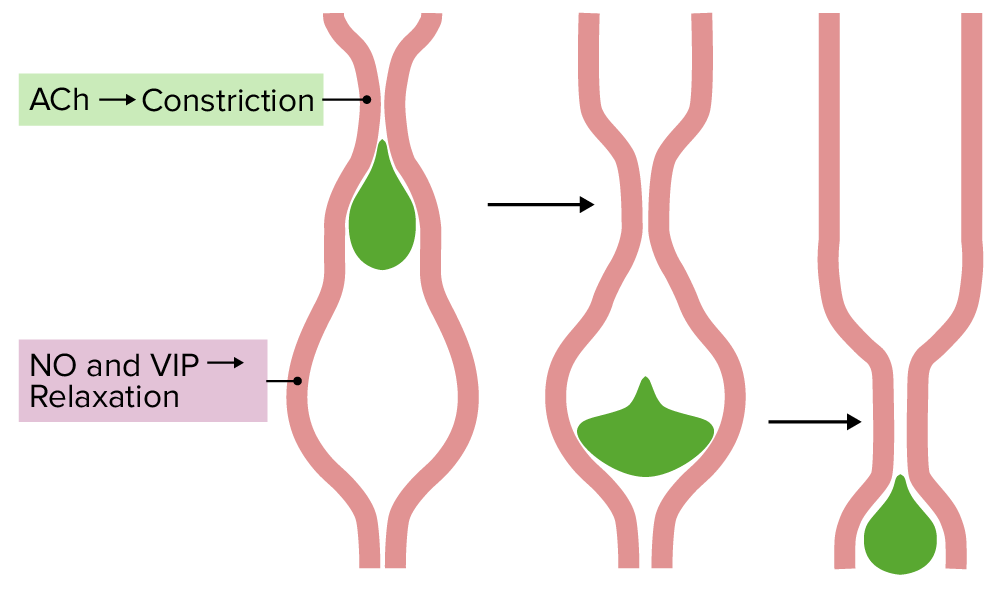Playlist
Show Playlist
Hide Playlist
Swallowing – Gastrointestinal Motility
00:00 Swallowing will help get that food stuff from the mouth down to the stomach where you can start to mix and grind it. 00:08 Swallowing is broken up into three different components. 00:11 One is a voluntary part and there are two involuntary parts. 00:18 But to start swallowing is a voluntary process. 00:24 Once you’ve pushed the food stuff back far enough in the throat though, you will enact an involuntary reflex. 00:33 And this can be seen in this particular diagram where we have the hard palate and soft palate. 00:38 The bolus of food there can be seen in the mid portion of the diagram. 00:46 That will be pushed a little bit backwards as this is delivered to the back of the throat. 00:52 You see it touches up against the epiglottis, which will then close over the airway, And that is done so that when you swallow, it goes down the esophagus and not the larynx and the trachea. 01:09 So the pharynx, you can think of that at the top of the swallowing reflex. 01:11 At the bottom of the reflex is the stomach. 01:16 There are two different sphincters that are involved. 01:18 One is the upper esophageal sphincter and the other is the lower esophageal sphincter. 01:23 I will highlight the lower esophagal sphincter right now because this is a site often of pathology. 01:28 So when people have an acid reflux or regurgitation or Barrett’s esophagus, these are problems that are associated with this lower esophageal sphincter. 01:41 What’s interesting about the whole process of swallowing is that it’s partly voluntary and partly involuntary. 01:48 Corresponding to that, there are striated muscles in the upper third portion of the swallowing reflex pathway. 01:56 The bottom two-thirds is composed of smooth muscle. 02:01 You don’t have the ability to regulate or voluntarily engage smooth muscle contraction. 02:07 It is a reflex response. 02:10 There is a swallowing center that’s located in the brainstem. 02:14 And this will coordinate both the striated and smooth muscle to try to get that whole bolus of food pushed down the esophagus in a coordinated manner because you can imagine if you did not have coordinated contractions, the bolus of food could get stuck somewhere along the esophagus. 02:37 Besides the swallowing center, there are a couple of different types of regulatory responses that will synapse to that. 02:45 One is part of the glosso pharyngeal nerve, which will provide some feedback from the efferents located in the throat area. 02:56 So these nerves will directly stimulate this muscle to contract. 03:04 Then the autonomic nerves will then be engaged usually more of a reflex type of a manner. 03:12 So let’s go through this process know as primary peristalsis. 03:15 The first wave of contraction that happens once you start the swallowing reflex, pushes food from, again, right at the back of throat all the way down to the stomach. 03:27 If for some reason, that primary peristalsis did not move all the food down to the stomach, you have a secondary mechanism called secondary peristalsis that will begin the process again. 03:42 What you need to have though at the bottom of the swallowing reflex is you need to have a relaxed stomach. 03:50 If the stomach was not relaxed, it would be unable to accept the food that would come to it. 03:56 So in this case, you have to release tonic constriction of the lower esophageal sphincter. 04:04 And that is done via a vasoactive intestinal peptide and one thing called receptive relaxation which is the top part of the stomach also relaxing. 04:15 So you relax the lower esophageal sphincter and the top part of the stomach, both with vasoactive intestinal peptide in order to accept the food that is coming down the throat. 04:27 Now, how do you coordinate these waves of contraction? This can be seen in this type of a diagram where you have time on the X-axis and this is where the striated and smooth muscle is. 04:41 That’s the upper esophageal sphincter. 04:45 We had to put a pressure transducer down the throat to be able to get these nice little waves. 04:51 And then there’s the lower esophageal sphincter. 04:54 So as you can see, there is a coordinated increase in pressure in a different timeframe all the way down to the stomach. 05:03 And hopefully, you can also see at that lower esophageal sphincter, there is a relaxation that occurs when you’re contracting the upper portion of the esophagus. 05:15 So here’s swallowing beginning and there is the relaxation of the stomach.
About the Lecture
The lecture Swallowing – Gastrointestinal Motility by Thad Wilson, PhD is from the course Gastrointestinal Physiology.
Included Quiz Questions
When does the process of involuntary swallowing start?
- When mechanoreceptors in the pharynx are engaged
- When the teeth start to grind the foodstuff
- When the tastebuds are triggered
- When the epiglottis covers the larynx
- When the lower esophageal sphinter relaxes
Which of the following statements is correct?
- Somatic nerves from the glossopharyngeal nerve innervate the upper 1/3 of the esophagus which is composed of striated muscle.
- Autonomic nerves from the glossopharyngeal nerve innervate the upper 1/3 of the esophagus which is composed of striated muscle.
- Autonomic nerves from the vagus nerve innervate the upper 1/3 of the esophagus which is composed of striated muscle.
- Autonomic nerves from the vagus nerve innervate the lower 2/3 of the esophagus which is composed of striated muscle.
- Somatic nerves from the glossopharyngeal nerve innervate the lower 2/3 of the esophagus which is composed of smooth muscle.
Which of the following is the correct sequence of events in the process of swallowing?
- Relaxation of the upper esophageal sphincter, primary peristalsis, secondary peristalsis, relaxation of the lower esophageal sphincter, relaxation of the cardia of the stomach
- Relaxation of the lower esophageal sphincter, primary peristalsis, secondary peristalsis, contraction of the lower esophageal sphincter, relaxation of the cardia of the stomach
- Relaxation of the upper esophageal sphincter, secondary peristalsis, primary peristalsis, contraction of the lower esophageal sphincter, relaxation of the cardia of the stomach
- Relaxation of the lower esophageal sphincter, primary peristalsis, secondary peristalsis, contraction of the lower esophageal sphincter, contraction of the cardia of the stomach
- Contraction of the lateral esophageal sphincter, primary peristalsis, secondary peristalsis, contraction of the medial esophageal sphincter, relaxation of the cardia of the stomach
Customer reviews
5,0 of 5 stars
| 5 Stars |
|
5 |
| 4 Stars |
|
0 |
| 3 Stars |
|
0 |
| 2 Stars |
|
0 |
| 1 Star |
|
0 |




